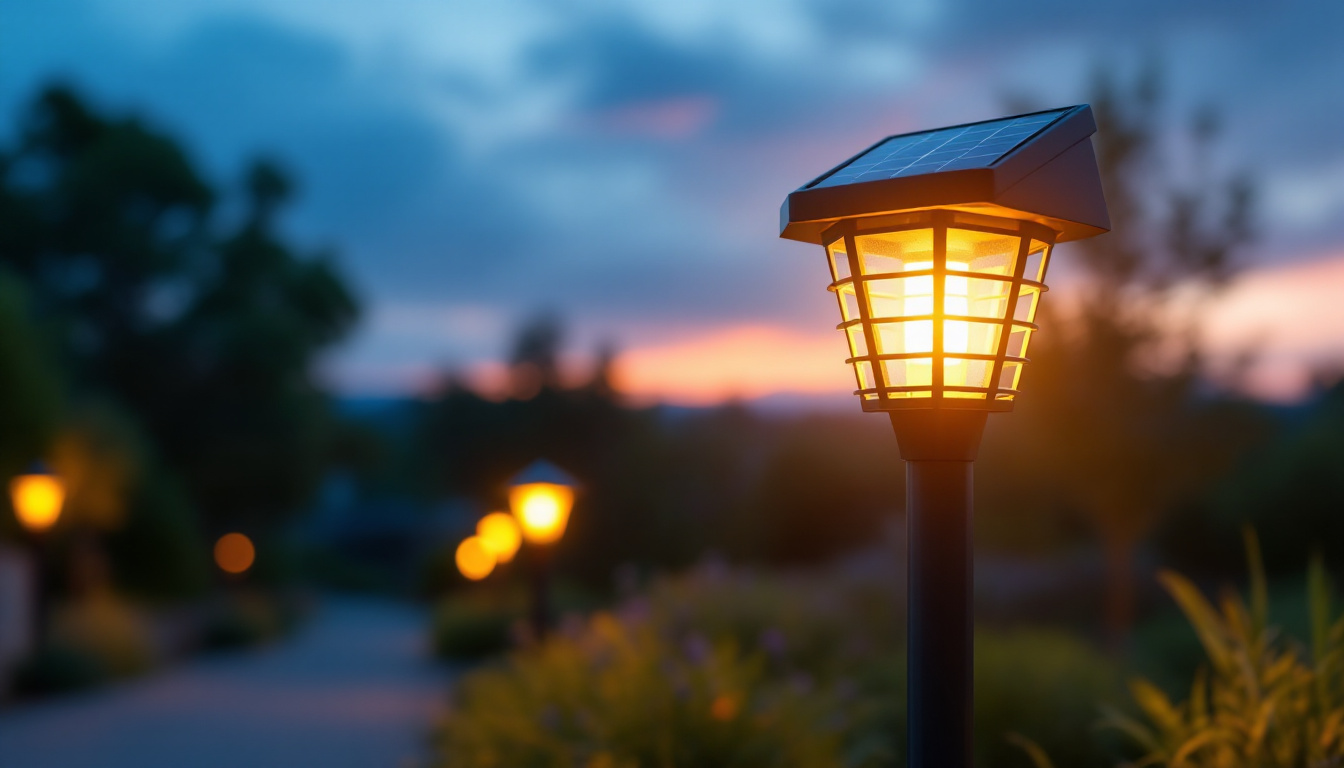
As the demand for sustainable and energy-efficient lighting solutions continues to rise, solar post light fixtures have become increasingly popular among homeowners and businesses alike. For lighting contractors, understanding the nuances of these fixtures is essential to ensuring successful installations and satisfied clients. This guide aims to highlight common pitfalls associated with solar post light fixtures and provide valuable insights to help contractors navigate this growing market.
Solar post light fixtures are outdoor lighting solutions powered by solar energy. They typically consist of a solar panel, LED lights, and a rechargeable battery, allowing them to operate without the need for electrical wiring. This feature makes them an attractive option for various applications, from illuminating pathways to enhancing garden aesthetics.
However, the performance and longevity of solar post lights can vary significantly based on several factors. A thorough understanding of these components and their interactions is crucial for contractors looking to deliver high-quality installations.
Each solar post light fixture comprises several key components that work together to provide illumination. The solar panel captures sunlight and converts it into electrical energy, which is stored in a rechargeable battery. When the sun sets, the stored energy powers the LED lights, illuminating the surrounding area.
Contractors should pay close attention to the quality of these components. For instance, low-quality solar panels may not capture enough sunlight, leading to inadequate charging and dim lighting. Similarly, inferior batteries can degrade quickly, resulting in shorter operational lifespans. Understanding the specifications and materials used in these components can help contractors make informed decisions when selecting products for their projects.
Solar post lights come in various styles and designs, catering to different aesthetic preferences and functional requirements. Some common types include traditional lantern-style lights, modern minimalist designs, and decorative fixtures that enhance landscape features.
Contractors should consider the specific needs of their clients when recommending a type of solar post light. For example, a client looking for a classic look may prefer a lantern-style fixture, while a modern home might benefit from sleek, contemporary designs. Additionally, understanding the intended use—whether for security, ambiance, or navigation—can guide the selection process.
While solar post lights offer numerous advantages, several common pitfalls can hinder their effectiveness. Awareness of these issues can help contractors avoid costly mistakes and ensure successful installations.
One of the most significant factors affecting the performance of solar post lights is their exposure to sunlight. Many contractors underestimate the importance of proper placement, which can lead to insufficient charging and poor illumination.
To avoid this pitfall, it is essential to assess the installation site thoroughly. Look for areas that receive direct sunlight for the majority of the day, avoiding shaded spots caused by trees, buildings, or other obstructions. Additionally, consider the seasonal changes in sunlight exposure, as the angle of the sun can vary significantly throughout the year.
Local climate conditions can significantly impact the performance and longevity of solar post lights. Factors such as temperature fluctuations, humidity, and precipitation can affect the efficiency of solar panels and the durability of the fixtures themselves.
For instance, extreme temperatures can cause batteries to degrade faster, while high humidity levels can lead to corrosion. Contractors should select solar post lights designed to withstand local climate conditions, ensuring that they are durable and reliable over time. Additionally, educating clients about the potential impacts of their specific environment can help set realistic expectations for performance.
While solar post lights are often marketed as low-maintenance solutions, they still require some level of upkeep to ensure optimal performance. Contractors should inform clients about the importance of regular maintenance, which can include cleaning solar panels, checking battery health, and replacing components as needed.
Encouraging clients to periodically clean the solar panels can significantly enhance their efficiency. Dust, dirt, and debris can accumulate on the surface, blocking sunlight and reducing charging capacity. Additionally, advising clients on battery replacement schedules can help maintain consistent performance and prolong the life of the fixtures.
With a myriad of options available on the market, selecting the right solar post light fixture can be overwhelming. However, by considering several key factors, contractors can make informed choices that align with their clients’ needs and preferences.
The brightness and light output of solar post lights are critical considerations. Measured in lumens, the light output determines how effectively a fixture can illuminate an area. Contractors should assess the intended use of the lights to determine the appropriate lumen output.
For example, pathway lighting may require lower lumens for subtle illumination, while security lighting necessitates higher lumens for enhanced visibility. Understanding the specific requirements of each project can guide contractors in selecting fixtures that provide adequate brightness for their clients’ needs.
Battery life and charging time are vital factors that influence the performance of solar post lights. High-quality batteries can provide longer operational periods and faster charging times, ensuring that lights remain functional even during cloudy days.
Contractors should look for fixtures with lithium-ion batteries, known for their longevity and efficiency. Additionally, understanding the average charging time for the selected fixtures can help contractors set realistic expectations for clients regarding performance during different weather conditions.
Aesthetic appeal plays a significant role in the selection of solar post light fixtures. The right design can enhance the overall look of a property, contributing to curb appeal and creating a welcoming atmosphere.
Contractors should engage clients in discussions about their design preferences, considering factors such as color, style, and material. Offering a range of options can help clients visualize how different fixtures will complement their outdoor spaces, ultimately leading to more satisfying outcomes.
Proper installation is crucial for the performance and longevity of solar post light fixtures. Following best practices can help contractors ensure that each installation is executed effectively, minimizing the risk of issues down the line.
Before installing solar post lights, it is essential to prepare the installation site adequately. This preparation includes clearing any debris, leveling the ground, and ensuring that the fixtures will receive adequate sunlight exposure.
Contractors should also verify that the mounting surfaces are stable and secure. For post-mounted fixtures, ensuring that the post is firmly anchored can prevent shifting or tilting over time, which could affect the light’s performance and aesthetic appeal.
Each solar post light fixture comes with specific manufacturer guidelines that outline installation procedures and best practices. Contractors should familiarize themselves with these instructions to ensure compliance and optimal performance.
Adhering to manufacturer guidelines can prevent common installation mistakes, such as improper wiring or incorrect mounting heights. Additionally, following these recommendations can help maintain warranties, providing clients with added peace of mind regarding their investment.
After installation, it is essential to test the solar post lights to ensure they function as intended. This testing phase allows contractors to identify any issues that may need addressing before the project is considered complete.
During the testing process, contractors should check the brightness levels, confirm that the lights turn on and off automatically, and assess the overall aesthetic placement. Making any necessary adjustments at this stage can enhance client satisfaction and prevent future complaints or service calls.
Client education is a critical component of successful solar post light installations. By providing clients with the necessary information about their new fixtures, contractors can help ensure that they are used effectively and maintained properly.
Clients should be informed about how solar post lights operate, including the importance of sunlight exposure and the role of the battery. Understanding these features can help clients appreciate the benefits of their new lighting solutions and set realistic expectations regarding performance.
Additionally, educating clients about any special features, such as motion sensors or adjustable brightness settings, can enhance their overall experience and satisfaction with the product.
Providing clients with clear maintenance guidelines can help prolong the life of solar post lights and ensure optimal performance. Contractors should outline the steps for cleaning solar panels, checking battery health, and replacing components as needed.
Offering a maintenance schedule or checklist can be a helpful resource for clients, allowing them to stay proactive in caring for their solar post lights. This guidance can lead to fewer service calls and increased client satisfaction over time.
Solar post light fixtures present an excellent opportunity for lighting contractors to offer sustainable and energy-efficient solutions to their clients. However, avoiding common pitfalls is essential to ensure successful installations and satisfied customers. By understanding the components, selecting the right fixtures, following best practices during installation, and educating clients on maintenance, contractors can navigate the solar lighting landscape with confidence.
As the market for solar lighting continues to expand, staying informed about trends, advancements, and client preferences will be key to thriving in this competitive industry. With the right knowledge and approach, lighting contractors can harness the power of solar post lights to illuminate outdoor spaces while contributing to a more sustainable future.
Ready to elevate your lighting projects with the best solar post light fixtures on the market? Look no further than LumenWholesale, where we provide contractors with superior, spec-grade lighting products at unbeatable wholesale prices. Our commitment to quality and affordability ensures you have access to reliable, high-performance lighting that meets the highest industry standards. Plus, with free shipping on bulk orders, you can enjoy premium lighting solutions without the hidden fees or compromises. Don’t let middleman markups dim your project’s potential. Discover wholesale lighting at the best value and light up your outdoor spaces with confidence and convenience.

Discover the crucial aspects lighting contractors frequently miss when working with Hydrofarm systems.

Discover the best places to purchase light fixtures with our expert guide tailored for lighting contractors.

Discover the essential checklist for lighting contractors working with RGB lights.

Discover how the 40W Type B bulb can transform your lighting solutions with enhanced efficiency and versatility.